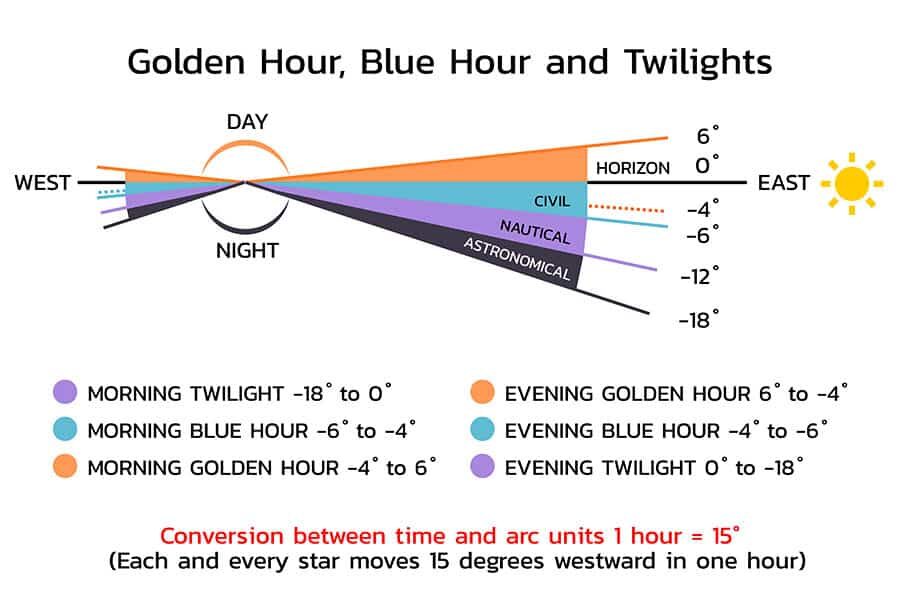Twilight vs Dusk – What is the Difference?
Many people get confused between the difference between twilight and dusk. Whilst they’re around the same period of time as each other, we generally refer to them as different periods of time when the Sun is falling below our horizon.
And when the Sun begins to drop beneath the horizon, these different twilight types begin to become noticeable. But how do you differentiate them from each other? Well, that’s what we’ll be defining; the difference between twilight and dusk.
Twilight simply refers to the period of time after the sun sets beneath the horizon, and the sky begins to get darker for us. Dusk is the period after twilight, when the sky is dark and the stars are easily visible. So, twilight directly transcends into dusk when the Sun is 18° beneath the horizon.
This is a very simple explanation when nautical, astronomical and civil twilight occurs, and it’s the perfect time for astronomical observations. However, there is more to it than this. So, let’s look at the stages of both and see how they’re different.
Twilight is separated into three different periods, depending on how far the Sun is beneath the horizon.
In the evening, first comes civil twilight. This is when the Sun is between 0° and 6° below the horizon. Things are still clearly visible around us, however it’s around the time you turn your garden lights on, and the street lights come on the side of the street.
After civil twilight comes nautical twilight, named because it was used as a navigational tool by seafarers who used the stars to help them navigate the seas. This is when the Sun is between 6° and 12° beneath the horizon. You can still make out the silhouettes of trees on the horizon, but it’s too dark to see them properly.
For astronomers, we’re waiting for the time that the Sun is between 12° and 18° beneath the horizon. This is astronomical twilight, and it’s when we can see the majority of stars and objects in our night sky clearly. So whilst all of these three periods of time are considered twilight, we still separate them from each other.
You also may hear the terms golden hour and blue hour. Golden hour refers to when the Sun is just dipping below the horizon, between 6° and -4°. Blue hour is a shorter time period between -4° and -6°. These times are considered to be the best for photographers, with very little artificial light.

When we’re talking about dusk, this generally is the period of time after twilight is finished. However, when we actually break it down further, we can split dusk into the three periods that are after the three periods of twilight.
 To the naked eye, these can often be confused with each other. That’s why we define them by the distance the Sun has travelled below the horizon.
To the naked eye, these can often be confused with each other. That’s why we define them by the distance the Sun has travelled below the horizon.
So, when civil twilight is finished and the Sun reaches 6° below the horizon, it then progresses into civil dusk. After civil dusk comes nautical twilight, and when the Sun reches 12° below the horizon it progresses into nautical dusk. And finally, after astronomical twilight and the Sun reaches 18° below the horizon, we call this astronomical dusk.
Although many people refer to astronomical as just dusk, we can categorize dusk into the three periods of time after each period of twilight. So, technically dusk isn’t just “after twilight”, as civil dusk actually precedes nautical twilight.
No, twilight and dusk are not the same period of time, but this can be pretty confusing. When people are referring to dusk, they generally refer to the period at the end of twilight when the sky is quite dark. However, we do separate dusk into three categories like we do with twilight, and they follow each period of twilight too. So, civil twilight progresses into civil dusk, which then goes into nautical twilight. So, whilst they are almost the same period in time, they’re different.
The difference between dusk and dawn is just that dusk is in the evening, and dawn is in the morning. Dawn still has the same periods of time that dusk has, like civil dawn and nautical dawn; they’re just name dawn in as the opposite of dusk. Interestingly enough, the term dawn comes from the Latin Goddess of dawn, Aurora. So, Aurora Borealis literally means “morning light from the North” and Aurora Australia means “morning light from the South”
Parts of twilight can be as short as only 20 minutes, before transcending into the next phase of twilight. This means that the period of civil dusk or nautical dusk can be even shorter.
We used the term twilight for both nighttime and morning. However, dusk is in the evening and dawn is in the morning, which is how we differentiate their times. So, in the morning civil twilight begins before the Sun has risen above the horizon. Before this, we have astronomical dawn, which is the transition from nighttime back into early morning.
Evening twilight begins when the sun declines below the horizon from our point of vision. So, it’s the period after sunset.
So in conclusion, twilight and dusk are not actually the same period of time, but they do blend into one another, so it’s difficult to notice the difference in the night sky. Both twilight and dusk are key for astronomers, as they represent a time when the stars and night sky objects are becoming more noticeable.
When the Sun is 6 degrees below the horizon, we’re in civil twilight. When the Sun is 12 degrees below the horizon, we’re in nautical twilight. And when the Sun is 18 degrees below the horizon, we’re in astronomical twilight – the ideal time for any astronomer.